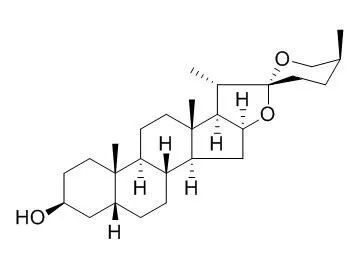| Description: |
Sarsasapogenin has antidiabetic, improving memory, antidepressant, anti-oxidative, anticancer and anti-inflamatory activities. It can effectively promote the proliferation,differentiation and mineralization of osteoblasts cultured in vitro, it also can inhibit the generation of osteoclasts from marrow cells. Sarsasapogenin potently inhibited NF-κB and MAPK activation, as well as IRAK1, TAK1, and IκBα phosphorylation in LPS-stimulated macrophages. |
| Targets: |
TLR | NF-kB | MAPK | IL Receptor | IkB | TNF-α | Beta Amyloid | ROS | Caspase | IKK | IRAK1 | TAK1 | CD4(+) |
| In vitro: |
| Int Immunopharmacol. 2015 Apr;25(2):493-503. | | Timosaponin AIII and its metabolite sarsasapogenin ameliorate colitis in mice by inhibiting NF-κB and MAPK activation and restoring Th17/Treg cell balance.[Pubmed: 25698557] | The rhizome of Anemarrhena asphodeloides (AA, family Liliaceae), which contains furostanol and spirostanol saponins, is a typical herbal medicine that improves learning and memory in rats and inhibits inflammation.
METHODS AND RESULTS:
In a preliminary study, timosaponin AIII, one of AA main constituents, was metabolized to Sarsasapogenin by gut microbiota and inhibited NF-κB activation in lipopolysaccharide (LPS)-stimulated macrophages. Here we have investigated the anti-inflammatory effects of AIII and Sarsasapogenin in vitro and in vivo. Both AIII and Sarsasapogenin potently inhibited NF-κB and MAPK activation, as well as IRAK1, TAK1, and IκBα phosphorylation in LPS-stimulated macrophages. Further, AIII and Sarsasapogenin inhibited the binding of LPS to macrophage Toll-like receptor 4, as well as polarization of M2 to M1 macrophages. Oral administration of AIII and Sarsasapogenin inhibited 2,3,4-trinitrobenzene sulfonic acid (TNBS)-induced colon shortening and myeloperoxidase activity in mice, along with reducing NF-κB activation and interleukin (IL)-1β, tumor necrosis factor (TNF)-α, and IL-6 levels, while simultaneously increasing IL-10. Both compounds inhibited Th17 cell differentiation in colonic lamina propria, but induced Treg cell differentiation. Further, AIII and Sarsasapogenin inhibited the differentiation of splenic CD4(+) T cells into Th17 cells in vitro. The vitro and in vivo anti-inflammatory effects of Sarsasapogenin were more potent than AIII.
CONCLUSIONS:
These results suggest that orally administered AIII may be metabolized to Sarsasapogenin by gut microbiota, which may ameliorate inflammatory diseases such as colitis by inhibiting TLR4-NF-κB/MAPK signaling pathway and restoring Th17/Treg cell balance. | | Cell Biol Int. 2007 Sep;31(9):887-92. | | The apoptotic effect of sarsasapogenin from Anemarrhena asphodeloides on HepG2 human hepatoma cells.[Pubmed: 17400003 ] | Sarsasapogenin, a kind of mainly effective components of Anemarrhena asphodeloides Bunge (Liliaceae) has the effects of being anti-diabetes and improving memory. However, there are few reports focusing on its anti-tumor effects.
METHODS AND RESULTS:
In this study, the Sarsasapogenin was extracted from rhizomes of A. asphodeloides Bunge and applied to inhibit HepG2 human hepatoma cells. MTT assay showed that Sarsasapogenin induced a distinct dose- and time-dependent diminution of cell viability with IC(50) of 42.4+/-1.0microg/ml for 48h. Furthermore, Sarsasapogenin-induced apoptosis of HepG2 cells was verified by Hoechst 33258 staining, electron microscopy, DNA fragmentation and PI staining. Flow cytometry analysis showed that Sarsasapogenin-induced cell apoptosis was through arrest of cell cycle in G(2)/M phase.
CONCLUSIONS:
Hence we proposed that Sarsasapogenin could be used as an anti-liver cancer drug for future studies. |
|
| In vivo: |
| Biol Pharm Bull. 2006 Nov;29(11):2304-6. | | Antidepressant-like effects of sarsasapogenin from Anemarrhena asphodeloides BUNGE (Liliaceae).[Pubmed: 17077534] |
METHODS AND RESULTS:
The aim of this study was to investigate the effects of Sarsasapogenin from Anemarrhena asphodeloides BUNGE (Liliaceae) on the forced swimming test, and the central noradrenergic, dopaminergic and serotonergic activities in mice. Our results showed that Sarsasapogenin treatment at 12.5, 25 and 50 mg/kg (p.o.) for 14 d significantly reduced the duration of immobility in the forced swimming test. These doses that affected the immobile response did not affect locomotor activity. In addition, the neurochemical assays showed that Sarsasapogenin produced a marked increase of noradrenaline and serotonin levels at 50 mg/kg in both the hypothalamus and the hippocampus. Moreover, Sarsasapogenin showed a monoamine oxidase inhibitory activity in the mouse brain.
CONCLUSIONS:
These findings suggest that the antidepressant activity of Sarsasapogenin may involve the central monoaminergic neurotransmitter systems. | | Neurosci Lett . 2017 Feb 3;639:173-178. | | Sarsasapogenin reverses depressive-like behaviors and nicotinic acetylcholine receptors induced by olfactory bulbectomy[Pubmed: 27988349] | | Abstract
Cholinergic signalling in the hippocampus may contribute to the aetiology of mood regulation. Antidepressants can reverse the increase in acetylcholinesterase (AChE) activity induced by olfactory bulbectomy. The activation of nicotinic acetylcholine receptors (nAChRs) also alleviates the symptoms of depression. This study advances the development of Sarsasapogenin, which interacts with cholinergic signalling and has a favourable antidepressant profile in olfactory bulbectomised (OB) rats. We examined OB-induced changes in cholinergic signalling, as well as AChE, α4-nAChR, and α7-nAChR expression in the hippocampus. The results indicate that abnormal cholinergic signalling in the hippocampus contributes to the development of depression in the OB rat model. This depression may be alleviated following treatment with Sarsasapogenin.
Keywords: Acetylcholinesterase; Depression; Olfactory bulbectomy; Sarsasapogenin; α4-nAChR; α7-nAChR. |
|






 Cell. 2018 Jan 11;172(1-2):249-261.e12. doi: 10.1016/j.cell.2017.12.019.IF=36.216(2019)
Cell. 2018 Jan 11;172(1-2):249-261.e12. doi: 10.1016/j.cell.2017.12.019.IF=36.216(2019) Cell Metab. 2020 Mar 3;31(3):534-548.e5. doi: 10.1016/j.cmet.2020.01.002.IF=22.415(2019)
Cell Metab. 2020 Mar 3;31(3):534-548.e5. doi: 10.1016/j.cmet.2020.01.002.IF=22.415(2019) Mol Cell. 2017 Nov 16;68(4):673-685.e6. doi: 10.1016/j.molcel.2017.10.022.IF=14.548(2019)
Mol Cell. 2017 Nov 16;68(4):673-685.e6. doi: 10.1016/j.molcel.2017.10.022.IF=14.548(2019)